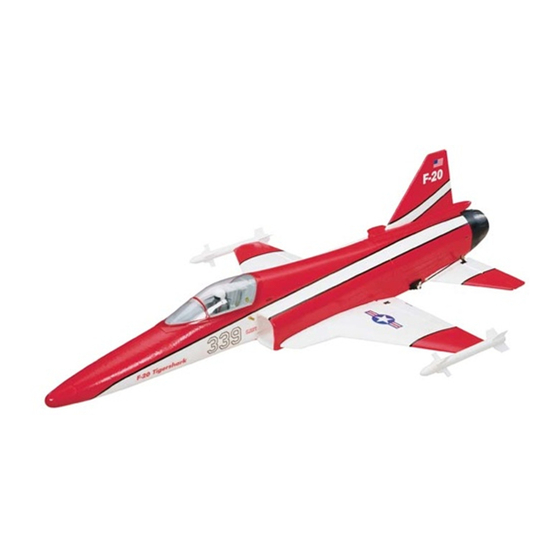- ページ 14
おもちゃ GREAT PLANES EP F-20 Tigershark ElectriFLyのPDF 取扱説明書をオンラインで閲覧またはダウンロードできます。GREAT PLANES EP F-20 Tigershark ElectriFLy 16 ページ。

AMA SAFETY CODE (
Read and abide by the following excerpts from the Academy
of Model Aeronautics Safety Code. For the complete Safety
Code refer to Model Aviation magazine, the AMA web site or
the Code that came with your AMA license.
1) I will not fl y my model aircraft in sanctioned events, air shows,
or model fl ying demonstrations until it has been proven to be
airworthy by having been previously, successfully fl ight tested.
2) I will not fl y my model aircraft higher than approximately
400 feet within 3 miles of an airport without notifying the
airport operator. I will give right-of-way and avoid fl ying in the
proximity of full-scale aircraft. Where necessary, an observer
shall be utilized to supervise fl ying to avoid having models fl y
in the proximity of full-scale aircraft.
3) Where established, I will abide by the safety rules for the
fl ying site I use, and I will not willfully and deliberately fl y my
models in a careless, reckless and/or dangerous manner.
5) I will not fl y my model unless it is identifi ed with my name
and address or AMA number, on or in the model. Note: This
does not apply to models while being fl own indoors.
7) I will not operate models with pyrotechnics (any device
that explodes, burns, or propels a projectile of any kind).
Radio Control
1) I will have completed a successful radio equipment ground
check before the fi rst fl ight of a new or repaired model.
2) I will not fl y my model aircraft in the presence of spectators
until I become a qualifi ed fl ier, unless assisted by an
experienced helper.
3) At all fl ying sites a straight or curved line(s) must be
established in front of which all fl ying takes place with the
other side for spectators. Only personnel involved with fl ying
the aircraft are allowed at or in the front of the fl ight line.
Intentional fl ying behind the fl ight line is prohibited.
4) I will operate my model using only radio control frequencies
currently allowed by the Federal Communications Commission.
5) I will not knowingly operate my model within three
miles of any pre-existing fl ying site except in accordance
with the frequency sharing agreement listed (in the
complete AMA Safety Code).
9) Under no circumstances may a pilot or other person
touch a powered model in fl ight; nor should any part of the
model other than the landing gear intentionally touch
the ground, except while landing.
EXCERPTS
General
)
During the last few moments of preparation your mind may
be elsewhere anticipating the excitement of the fi rst fl ight.
Because of this, you may be more likely to overlook certain
checks and procedures that should be performed before the
model is fl own. To help avoid this, a check list is provided to
make sure these important areas are not overlooked. Many
are covered in the instruction manual, so where appropriate
refer to the manual for complete instructions. Be sure to
check the items off as they are completed.
❏
1. Check the C.G. according to the measurements
provided in the manual.
❏
2. Be certain the battery and receiver are securely
mounted in the fuselage.
❏
3. Confi rm that all controls operate in the correct direction
and the throws are set up according to the manual.
❏
4. Inspect the ducted fan unit for obvious damage and
tighten the fan screw.
❏
5. Check the operation of the ducted fan unit prior to
each fl ight.
❏
6. Make sure that all servo arms are secured to the
servos with the screws included with your radio.
❏
7. Place your name, address, AMA number and telephone
number on or inside your model.
❏
8. If you wish to photograph your model, do so before
your fi rst fl ight.
❏
9. Range check your radio when you get to the fl ying fi eld.
IMPORTANT: If you are an inexperienced modeler we
strongly urge you to seek the assistance of a competent,
experienced R/C pilot to check your model for airworthiness
AND to teach you how to fl y. Attempting to learn to fl y on your
own is dangerous and may result in destruction of your model
or even injury to yourself and others. You should fl y under
the careful watch of an instructor until you have acquired
the skills necessary for safe and fully controlled operation of
your model.
Less-experienced fl yers should fl y the F-20 EDF ARF only
in calm (less than fi ve miles per hour) conditions. Frequently,
winds are calm in the early morning and early evening. Often
these are the most enjoyable times to fl y anyway!
We suggest always using a skilled assistant to help you
launch the airplane. Use HIGH rates for takeoff and let the
model build up speed before attempting to climb out.
Turn on the transmitter and plug the battery into the ESC. Turn
on the receiver by following the instructions that came with your
ESC. Secure the canopy hatch in place.
14
